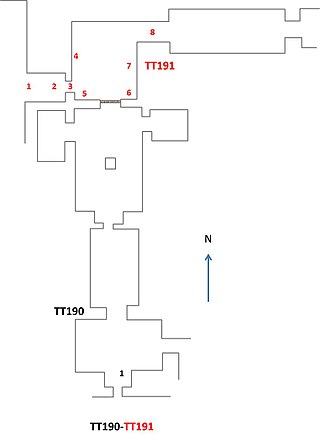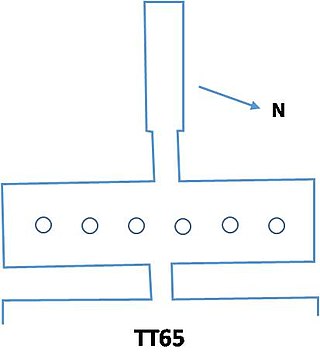
Thebes, known to the ancient Egyptians as Waset, was an ancient Egyptian city located along the Nile about 800 kilometers (500 mi) south of the Mediterranean. Its ruins lie within the modern Egyptian city of Luxor. Thebes was the main city of the fourth Upper Egyptian nome and was the capital of Egypt for long periods during the Middle Kingdom and New Kingdom eras. It was close to Nubia and the Eastern Desert, with its valuable mineral resources and trade routes. It was a religious center and the most venerated city during many periods of ancient Egyptian history. The site of Thebes includes areas on both the eastern bank of the Nile, where the temples of Karnak and Luxor stand and where the city was situated; and the western bank, where a necropolis of large private and royal cemeteries and funerary complexes can be found. In 1979, the ruins of ancient Thebes were classified by UNESCO as a World Heritage Site.

The necropolis of Draʻ Abu el-Naga' is located on the West Bank of the Nile at Thebes, Egypt, just by the entrance of the dry bay that leads up to Deir el-Bahari and north of the necropolis of el-Assasif. The necropolis is located near the Valley of the Kings.

The Valley of the Kings, also known as the Valley of the Gates of the Kings, is an area in Egypt where, for a period of nearly 500 years from the Eighteenth Dynasty to the Twentieth Dynasty, rock-cut tombs were excavated for pharaohs and powerful nobles under the New Kingdom of ancient Egypt.

Nakht was an ancient Egyptian official who held the position of a scribe and astronomer of Amun, probably during the reign of Thutmose IV of the Eighteenth Dynasty. He was buried in the Theban Necropolis in tomb TT52.
The ancient Egyptian official named Menna carried a number of titles associated with the agricultural estates of the temple of Karnak and the king. Information about Menna comes primarily from his richly decorated tomb in the necropolis of Sheikh Abd al-Qurna at Thebes. Though his tomb has traditionally been dated to the reign of Thutmose IV, stylistic analysis of the decoration places the majority of construction and decoration of the tomb to the reign of Amenhotep III.

Tomb TT280, located in Sheikh Abd el-Qurna, part of the Theban Necropolis, is the burial place of the ancient Egyptian noble Meketre who was chancellor and chief steward during the reign of Mentuhotep II and Mentuhotep III, during the Eleventh Dynasty.

Tomb TT196, located in the necropolis of El-Assasif in Thebes, Egypt, is the tomb of Padihorresnet, who was a chief steward of Amun during the Twenty-sixth Dynasty of Egypt. Padihorresnet's tomb is part of the TT192 tomb complex.

The Theban Tomb TT33 is an ancient Egyptian tomb. Located in El-Assasif, it is part of the Theban Necropolis on the west bank of the Nile, opposite to Luxor. The tomb is the burial place of the ancient Egyptian Padiamenope, who was Prophet and Chief Lector Priest during the 26th Dynasty.

A necropolis is a large, designed cemetery with elaborate tomb monuments. The name stems from the Ancient Greek νεκρόπολις nekropolis.

The Theban Tomb TT15 is located in Dra' Abu el-Naga', part of the Theban Necropolis, on the west bank of the Nile, opposite to Luxor. It is the burial place of the ancient Egyptian Tetiky, who was Mayor of Thebes, during the reign of Ahmose I, during the early Eighteenth Dynasty.

Dagi was an ancient Egyptian vizier during the reign of pharaoh Mentuhotep II of the Eleventh Dynasty.

Roma called Roy was High Priest of Amun during the Nineteenth Dynasty of Egypt, at the end of the reign of Ramesses II and continued into the reigns of Merenptah and likely Seti II. Roma served as third and second priest of Amun and finally as first prophet of Amun. He was also a count (h3ty-a), a prince (iry-pat) and a divine father pure of hands.

Tomb TT190, located in the necropolis of El-Assasif in Thebes, Egypt, is the tomb of Esbanebded and part of the TT192 tomb complex.

Mentuemhat or Montuemhat was a rich and powerful Theban official from ancient Egypt who lived during the Twenty-fifth Dynasty of Egypt and Twenty-sixth Dynasty of Egypt. He was the Fourth Priest of Amun in Thebes.

The Theban Tomb TT385 is located in Sheikh Abd el-Qurna, part of the Theban Necropolis, on the west bank of the Nile, opposite Luxor. It is the burial place of the ancient Egyptian Hunefer (Haunefer), who was a Mayor of the Southern City (Thebes) during the reign of Ramesses II in the Nineteenth Dynasty.

Pedubast was an ancient Egyptian official during the 26th Dynasty. He is so far only known from his burial, found within the larger and earlier tomb complex of the mayor of Thebes Karabasken (TT391), located at South El-Assasif within the Theban Necropolis, in Upper Egypt.
Pedubast's burial was found in 2015 and announced shortly after. He was most likely the grandson of the well known chief steward of the God's Wife Pabasa who was buried in another large funerary complex at Thebes (TT279). Pedubast was overseer of Upper Egypt and chief steward of the God's Wife; in the latter position he managed the estates of the God's Wife of Amun, the leading religious figure in southern Egypt at the time. Pedubast only reinscribed some parts of the burial chapel of Karabasken. It seems that he was only for a short time in office having not enough time to build an own monumental tomb. The newly decorated parts include a door frame and a sun hymn. Fragments of his coffin were found too.

The Theban Tomb TT65 is located in Sheikh Abd el-Qurna. It forms part of the Theban Necropolis, situated on the west bank of the Nile opposite to Luxor.
The Theban Tomb C.8 is an ancient Egyptian tomb in Thebes, Upper Egypt. It is located in Sheikh Abd el-Qurna, part of the Theban Necropolis on the west bank of the Nile opposite Luxor. It is the burial place of the ancient Egyptian Nakht, who was the Overseer of the fowl-houses in the Estate of Amun.
Christopher Hugh Naunton is a British Egyptologist, a writer and a broadcaster, and an expert on the life of Flinders Petrie.















